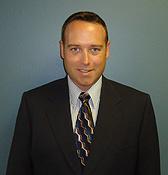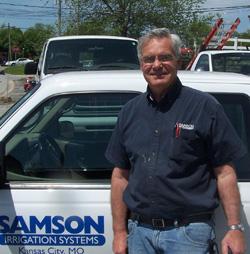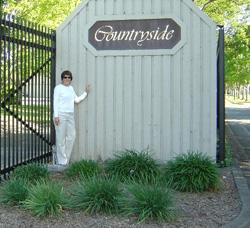Certified Professionals in Action

Learn how irrigation professionals certified by WaterSense labeled programs are helping their customers save water outdoors. If you have an irrigation system, use the Directory of Certified Professionals to find a certified professional in your area who can help ensure your system operates efficiently. To learn the benefits of hiring a certified irrigation professional and find questions to ask your contractor to ensure you are maximizing the water-efficiency of your system, visit Irrigation With a Pro.
On This Page:
- Judy Benson, Winter Springs, FL
- Christopher Curry, Orange, CA
- Victor Samson, Kansas City, MO
- Valerie Silva, Santa Rosa, CA
Judy Benson, Winter Springs, FL (CIC, CID, and CLIA Certified)
 Judy Benson, founder of Clear Water Products & Services, Inc. (Clear Water PSI), specializes in older irrigation system renovations. Benson provides customers with irrigation audits and landscape evaluation reports highlighting maintenance and renovation recommendations, as well as estimated water use reductions. Clear Water PSI ensures clients continue saving water by providing detailed, onsite training to detect leaks and operate controllers post-installation.
Judy Benson, founder of Clear Water Products & Services, Inc. (Clear Water PSI), specializes in older irrigation system renovations. Benson provides customers with irrigation audits and landscape evaluation reports highlighting maintenance and renovation recommendations, as well as estimated water use reductions. Clear Water PSI ensures clients continue saving water by providing detailed, onsite training to detect leaks and operate controllers post-installation.
She requires new Clear Water PSI irrigation systems to meet or exceed 70 percent distribution uniformity, which measures how evenly water is applied to a landscape. Remote technology is sometimes implemented on larger systems, allowing her to work proactively with clients to save water and prevent yard damage from malfunctioning equipment.
Benson has helped central Florida residents and businesses save millions of gallons of water. Between 2006 and 2008, Clear Water PSI worked with the Toho Water Authority’s rain sensor program and assisted homeowners with high outdoor water use. Technicians educated consumers and conducted irrigation evaluations that helped bring them into compliance with local watering restrictions. These recommendations were estimated to save each participating residence 5,200 gallons per month. Additionally, her work with Seminole County’s Irrigation Evaluation Program resulted in an average 37 percent reduction—an estimated 68 million gallons annually—in irrigation water use for the 548 participating residences.
Christopher Curry, Orange, CA (CLIA Certified)
 Christopher Curry, a principal at Sweeney & Associates Irrigation Design and Consulting, has been designing water-efficient irrigation systems for more than a decade. His projects range in size from small residences to large regional parks and have two things in common: (1) taking advantage of smart irrigation technology and (2) managing water use through application schedules and annual water budgets.
Christopher Curry, a principal at Sweeney & Associates Irrigation Design and Consulting, has been designing water-efficient irrigation systems for more than a decade. His projects range in size from small residences to large regional parks and have two things in common: (1) taking advantage of smart irrigation technology and (2) managing water use through application schedules and annual water budgets.
In 2010, Curry presented the City of Riverside, California, with a drip irrigation plan for some of its medians. With a projected savings of 1 million gallons of water per year, reduced street overflow, and more cost-effective installation, Riverside decided not only to install drip irrigation systems in those medians, but in all of the medians across the city. Curry also helped the San Diego Park & Recreation Department acquire a new rotor system that uses recycled water and a central control system. The project is expected to save the city as much as 3 million gallons of water per year on just 10 acres of turf. Additionally, Curry's work upgrading irrigation controllers for the Granada Park Home Owners Association (HOA) reduced water use on their four-acre grounds by 28 percent, saving the HOA more than $2,800 in just six months. The HOA expects the investment in system upgrades to pay for itself in less than five years.
Victor Samson, Kansas City, MO (CID and CLIA Certified)
 Victor Samson and his company Samson Irrigation know that installing water-efficient technology is just one aspect of maintaining a water-efficient landscape irrigation. Samson Irrigation manages and operates a number of sites using smart irrigation technologies that use evapotranspiration (ET) calculations to determine whether a lawn or landscape needs to be watered. These technologies apply water based on weather station data, gauge how much rainfall the site has received, and monitor the water flow of each station in the system to detect leaks. In addition, Samson ensures that irrigation systems are installed and maintained properly to prevent water waste.
Victor Samson and his company Samson Irrigation know that installing water-efficient technology is just one aspect of maintaining a water-efficient landscape irrigation. Samson Irrigation manages and operates a number of sites using smart irrigation technologies that use evapotranspiration (ET) calculations to determine whether a lawn or landscape needs to be watered. These technologies apply water based on weather station data, gauge how much rainfall the site has received, and monitor the water flow of each station in the system to detect leaks. In addition, Samson ensures that irrigation systems are installed and maintained properly to prevent water waste.
Whenever possible, Samson demonstrates to his customers how much water and money they are saving by using smart irrigation technologies. For example, at a townhouse complex where his company installed a smart controller, a valve malfunctioned only days after a visual inspection of the irrigation system. The smart controller detected the leak, shut off, and notified Samson to visit the site, where he repaired the problem. If the controller had not detected the broken valve, it probably would not have been noticed for a month or more. Based on the watering schedule over the next month, the leak could have wasted as much as 262,440 gallons of water, at a cost of approximately $500.
Valerie Silva, Santa Rosa, CA (QWEL Certified)
 Valerie Silva includes low water-using and native plants in her landscape designs whenever possible and provides her clients with a water use projection as part of the design plan.
Valerie Silva includes low water-using and native plants in her landscape designs whenever possible and provides her clients with a water use projection as part of the design plan.
Silva has put her Qualified Water-Efficient Landscaper (QWEL) certification and landscape design experience to good use as the chair of the Homeowners’ Association (HOA) Common Area Landscape Committee in Santa Rosa, California. Led by Silva, the HOA Landscape Committee redrafted the neighborhood architectural guidelines to include a list of water-efficient plants that would be good replacements for turf, while providing the contiguous look between the properties required by the HOA's codes. In the common area, 10,000 square feet of turf was removed and replaced with a few large native trees and shrubs that do not require summertime watering. The approach was to maintain lawn only where it is used for recreation or community gatherings. The original, poorly designed irrigation system was retrofitted with smart irrigation controllers. The community expects to reduce annual landscape water use by at least 30 percent.
John Taylor, Houston, TX (Certified Texas Landscape Irrigation Auditor)
 John Taylor, president of Taylor Irrigation Service, Inc., works with customers and landscaping company owners in the greater Houston area to educate them on the selection of native plants, appropriate watering schedules, and water-efficient irrigation systems. He installs WaterSense labeled irrigation controllers and uses the guidelines from the WaterSense new home specification to design water-efficient irrigation systems. Taylor’s services also emphasize homeowner education as an essential component of continuing to save water. By overhauling his company’s business model to focus on water-smart landscape and irrigation practices, Taylor offers a popular service that helps his community save water and money.
John Taylor, president of Taylor Irrigation Service, Inc., works with customers and landscaping company owners in the greater Houston area to educate them on the selection of native plants, appropriate watering schedules, and water-efficient irrigation systems. He installs WaterSense labeled irrigation controllers and uses the guidelines from the WaterSense new home specification to design water-efficient irrigation systems. Taylor’s services also emphasize homeowner education as an essential component of continuing to save water. By overhauling his company’s business model to focus on water-smart landscape and irrigation practices, Taylor offers a popular service that helps his community save water and money.
Although weather-based systems can cost more upfront than standard systems, Taylor finds that when his customers see the return on investment and health of their landscapes, water-efficient irrigation system become an obvious choice. After installing WaterSense labeled controllers on his customers’ irrigation systems, Taylor monitors their water bills and estimates an average of 35 to 45 percent reduction in water consumption and payback periods as short as three years. One of Taylor’s landscape installations saved a Houston-area homeowner more than 200,000 gallons of water in the first six months. His irrigation system upgrades at the historic Palmer Memorial Church reduced water use by 72,000 gallons in the first nine months.
